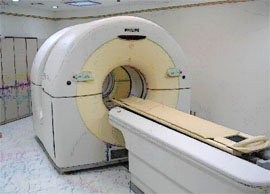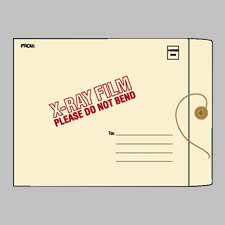 While this is, technically, the first time I’ve had this particular type of scan, it’s not really all that new to me. I’ve had CT scans before, and I’ve had PET scans before. This machine is a hybrid, that does both at once. The chief advantage is that I don’t have to go for two separate scans. (The last time I had a PET scan, I had to first have a CT scan, then wait a week or so for the films and narrative report to come back, before schlepping both of these to over the PET scan place.)
While this is, technically, the first time I’ve had this particular type of scan, it’s not really all that new to me. I’ve had CT scans before, and I’ve had PET scans before. This machine is a hybrid, that does both at once. The chief advantage is that I don’t have to go for two separate scans. (The last time I had a PET scan, I had to first have a CT scan, then wait a week or so for the films and narrative report to come back, before schlepping both of these to over the PET scan place.)My destination today is Atlantic Medical Imaging, a spanking-new facility in nearby Wall Township. It’s the latest branch of a large radiological-imaging company headquartered in the Atlantic City area. Ordinarily, I would patronize our local hospital for this kind of service, but the fusion scan isn’t available anyplace else in this area.
The waiting room, with its designer furniture and huge flat-screen TV on the wall, looks like some posh health club. As they lead me down the hall (after filling out the obligatory paperwork), we pass an artificial waterfall. They’ve spared no expense in building this place, I think to myself.
 Pat, the technician, ushers me into a private room with a radioactive symbol on the door, and seats me in a large lounge chair. After asking some preliminary questions and starting an IV line, she leaves for a moment, then returns with what looks like a little metal lunchbox. I can tell from the way she hefts it onto the counter that it’s very heavy. It’s lined with lead, and contains the radioactive source material that will shortly be injected into my veins. Opening the box, Pat removes a shiny, stainless-steel-clad cylinder about four inches long and two inches wide. It, too, looks heavy – probably lead-sheathed, underneath the stainless steel. Extending from one end is a plastic plunger, such as you’d ordinarily see on a hypodermic syringe. Pat lines up one end of the cylinder with the plastic tube hanging from the inside of my right elbow, presses the plunger on the other end, and that’s that. I’m to sit quietly for forty-five minutes, she instructs me, while the radioactive glucose solution works its way through my body.
Pat, the technician, ushers me into a private room with a radioactive symbol on the door, and seats me in a large lounge chair. After asking some preliminary questions and starting an IV line, she leaves for a moment, then returns with what looks like a little metal lunchbox. I can tell from the way she hefts it onto the counter that it’s very heavy. It’s lined with lead, and contains the radioactive source material that will shortly be injected into my veins. Opening the box, Pat removes a shiny, stainless-steel-clad cylinder about four inches long and two inches wide. It, too, looks heavy – probably lead-sheathed, underneath the stainless steel. Extending from one end is a plastic plunger, such as you’d ordinarily see on a hypodermic syringe. Pat lines up one end of the cylinder with the plastic tube hanging from the inside of my right elbow, presses the plunger on the other end, and that’s that. I’m to sit quietly for forty-five minutes, she instructs me, while the radioactive glucose solution works its way through my body.I feel no different, as all this is going on. In fact, I rather enjoy the quiet time, with a book on my lap. As I relax, I’m also aware that, if there are cancerous cells still in my body, they’re slurping up the radioactive glucose solution. Rapidly-metabolizing cancer cells are ravenous, that way. That’s what enables the PET scanner to find them: it picks up the radioactive material that’s chemically bonded to the glucose.
Forty-five minutes later, Pat returns and ushers me into the scanner room. The machine looks much like a regular CT scan or PET scan machine, except that the circular opening (the inside of the donut) is two to three times deeper. She and another technician lay me down on the sliding table, position my legs and head comfortably, then direct me to put my arms at my sides. Then, they wrap up my entire mid-section, arms and all, inside a large vinyl strap with velcro closures. It makes me feel like a mummy – although, I have to say, the position is easier to endure than the hands-over-the-head posture of my previous PET scans, which I found quite uncomfortable. The scan itself probably takes 30 minutes or so, but the time goes more quickly than before (probably because I’m in a more comfortable position).
Once the PET scan is over, another team comes in to conduct a CT scan of my chest (this is for my pulmonologist, Dr. De La Luz, who’s following up on Dr. Lerner’s referral, concerning a small spot in one lung which showed up on the last CT scan). A member of the CT-scan team tells me they would ordinarily do this in a different room, but because the air conditioning in that room is broken down, they will use the fusion machine.
For this one, they do want my arms up over my head. Immediately before the scan begins, the technicians retreat behind a plate glass window. By remote control, they inject a contrast solution into the IV tube in my right arm. I can feel a sort of popping sensation coming from the plastic tube. Something has evidently gone wrong with the IV line. The technicians interrupt the scan, and hurriedly mop up some solution that has spilled from the tube onto the machine. (Is this hazardous waste, I wonder? They do seem very concerned to get every little bit of it mopped up.) Apologizing for the inconvenience, they insert a new IV line in my left arm, and go through the entire process again, completing it this time.
 Afterwards, I phone over to the file room at Ocean Medical Center, telling them I’ll be driving over to reclaim my previous CT Scan and PET scan films. The radiologist at Atlantic Medical Imaging, I’ve been told, will need to compare my new results with the old ones. The OMC people give me a bit of a scare, when they tell me their computer says the films are still checked out to me.
Afterwards, I phone over to the file room at Ocean Medical Center, telling them I’ll be driving over to reclaim my previous CT Scan and PET scan films. The radiologist at Atlantic Medical Imaging, I’ve been told, will need to compare my new results with the old ones. The OMC people give me a bit of a scare, when they tell me their computer says the films are still checked out to me.“No, they’re not," I tell them. "I returned them.”
“Let me check the files in the basement,” the clerk tells me. A few minutes later she phones me back. Yes, the films are all there. Someone evidently forgot to note them in the computer as returned.
It’s one more example of how important it is to be proactive about one’s own health care. I make a mental note: my test results are now divided between two places - the CT Scan and PET Scan films are at Atlantic Medical Imaging, and everything else is still at Ocean Medical. I’ve got to keep track of these things. I’ve learned to trust no one else to do it for me.